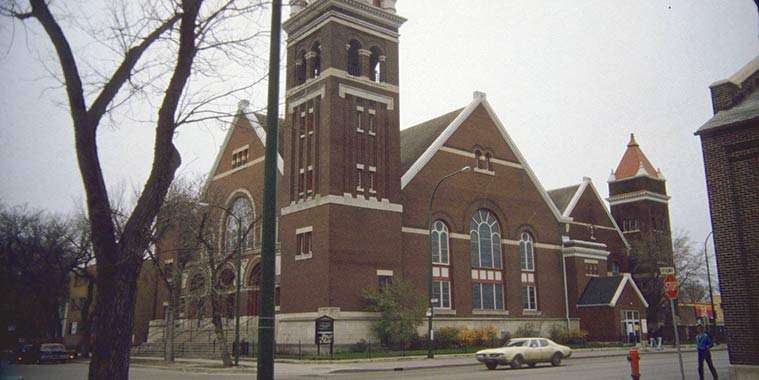The recent devastation of Notre Dame de Paris brought back memories of the St. Boniface Basilica fire of 1968. There are several other large churches in the city that suffered similar blazes and, like St. Boniface, rose from the ashes.
St. Matthews Anglican Church
641 St. Matthews Ave. at Maryland
The fourth home of St. Matthews Church was constructed in 1913. Three storeys in height with room for 1,100 people, the massive building was a dominant feature on the West End’s skyline.
Its devastating blaze began at around 4:00 a.m. on November 13, 1944. The fire’s origin was believed to be the boiler room from which it quickly spread up the building’s north wall and into the roof.
Firefighters broke through the stained-glass windows to pump water inside the building, but it was in vain. Three hours later, the north gable collapsed bringing the roof structure down with it. It was said that the church’s steel beams glowed red against the backdrop of the black sky.
All that remained by the afternoon were three partial walls and a pile of twisted steel.
Architect C. N. Semmens was hired to plan out the church’s next steps. His priority was to put a temporary roof over the shell to protect it.
An examination of the building’s basement, home to its Sunday school and other community programs, was found charred but structurally sound. It was cleaned out and reopened six weeks later just in time to host 700 people at a Christmas service. “The crypt” was the scene of hundreds of Sunday services, weddings, funerals and baptisms over the next two years.
The congregation had to raise $75,000 over and above the $60,000 in insurance money to rebuild. The fundraising and reconstruction took place simultaneously starting in the summer of 1945.
The exterior of the church is a near replica of the 1913 building it replaced. The interior was said to be similar to its 1913 version as well.
St. Matthews Church’s congregation held its first service above ground in its new home on February 2, 1947.
Elim Chapel
546 Portage Avenue at Spence
This church was constructed in 1903 as St. Stephens Presbyterian and became home to the non-denominational Elim Chapel in 1927.
A fire started in the altar area on the night of Friday, October 25, 1974. Once flames spread into the building’s vast false ceiling space the blaze was near impossible to fight and the structure burned into the next morning.
The interior of the church was destroyed, and a large portion of the west wall collapsed. Much of the remaining exterior walls remained standing and structurally sound. The damage was estimated at $1 million which included $100,000 for the three-keyboard Casavantes organ, one of the largest in the city.
Police arrested a 24-year-old man who had set three other church fires that week. He had a history of mental illness and claimed that voices were directing him. In the end, he was found not guilty and sent to Selkirk Mental Hospital.
The 300-member congregation voted to rebuild Elim Chapel and spent the paltry $150,000 in insurance money on a temporary roof over the burned-out shell to prevent further damage. Over the next three years, they raised around $600,000 and negotiated a mortgage for $449,000 more to fund the project.
Elim Chapel’s basement was the first section of the building to reopen in 1978. It contained an auditorium, which doubled as a temporary worship space, classrooms, kitchen, nursery and gym.
The exterior was renovated and a new roof added. Some of the stained-glass windows are ones that were rescued after the fire. The congregation opted for a contemporary interior rather than to recreate the original.
On March 25, 1979, the new Elim Chapel was dedicated with a special service followed by a reception.
Young United Church
222 Furby Street at Broadway
Young Methodist Church constructed in 1907 with a large addition added in 1910. It had a seating capacity of around 1,100 and a Sunday School area that could hold hundreds more.
Fire broke out in the basement of the church on the night of December 27, 1987. It spread quickly through its timber frame and within the hour the roof and front wall had collapsed. The structure was a total loss except for its east tower which received only a charring.
Police arrested three children, ages 12, 13 and one under 12. The youngest could not be charged due to his age and charges against the older boys were stayed after inconsistent testimony caused the court case to fall apart.
The 250-member congregation decided to rebuild but knew that a 1,100-seat church was not what they or the neighbourhood needed. Instead, they partnered with Day Nursery Centre, Broadway Child Care, West Broadway Youth Outreach, West Broadway Community Ministry, Hope Mennonite Church and Artemis Housing Coop to construct a four storey, mixed-use building called Crossways in Common.
Designed by Prairie Architects Inc., the new building was meant to resemble a church from the outside and incorporated the saved tower. The chapel space inside seats 300.
A ground-breaking ceremony for Crossways in Common took place in April 1992 and Young United Church held its first service in its new home on September 12, 1993.
Christian writes about local history on his blog, West End Dumplings.



